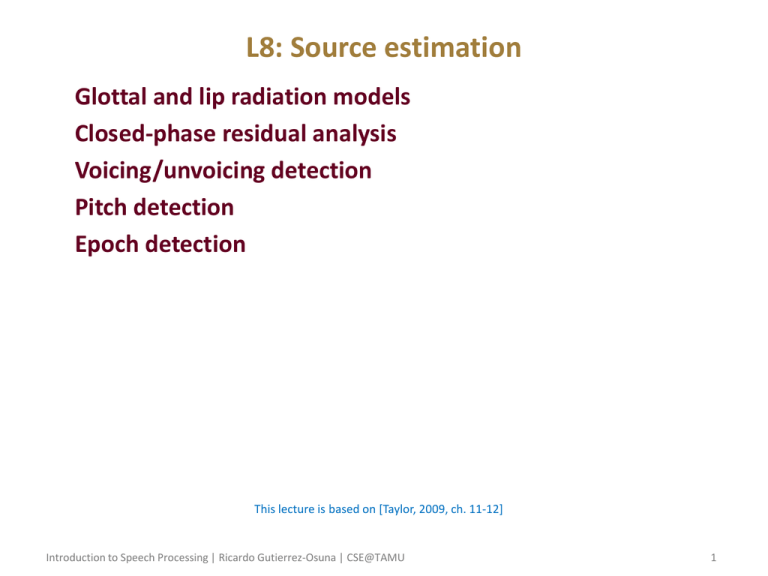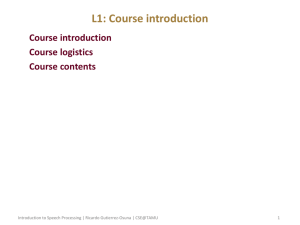L8: Source estimation
advertisement

L8: Source estimation • • • • • Glottal and lip radiation models Closed-phase residual analysis Voicing/unvoicing detection Pitch detection Epoch detection This lecture is based on [Taylor, 2009, ch. 11-12] Introduction to Speech Processing | Ricardo Gutierrez-Osuna | CSE@TAMU 1 Review • Components of the speech system – As we saw in a previous lecture, the speech system can be described as a sequence of filters in series (at least for vowels) 𝑌 𝑧 =𝑈 𝑧 𝑃 𝑧 𝑂 𝑧 𝑅 𝑧 – where • • • • 𝑈 𝑧 P 𝑧 𝑂 𝑧 𝑅 𝑧 is the glottal source is the transfer function at the pharynx is the transfer function at the oral cavity is the transfer function at the lips – Pharynx and oral TFs are normally combined as 𝑉 𝑧 = 𝑃 𝑧 𝑂 𝑧 , which leads to 𝑌 𝑧 =𝑈 𝑧 𝑉 𝑧 𝑅 𝑧 – The previous lecture dealt with the modeling of 𝑉 𝑧 ; this lecture focuses on models of the other two components: 𝑈 𝑧 and 𝑅 𝑧 Introduction to Speech Processing | Ricardo Gutierrez-Osuna | CSE@TAMU 2 Lecture 8 Lecture 7 Lecture 8 http://www.phys.unsw.edu.au/jw/graphics/voice3.gif Introduction to Speech Processing | Ricardo Gutierrez-Osuna | CSE@TAMU 3 Glottal and radiation models • Lip radiation – The LP transfer function we have developed in the previous lecture measures volume velocity at the lips relative to that at the glottis • In practice, however, microphones measure pressure waves • Most microphones also operate in the far field, where the signal is influenced by radiation impedance from the lips – It can be shown that radiation can be approximated as a derivative, which we can model as an FIR filter with a single zero 𝑅 𝑧 = 1 − 𝛼𝑧 −1 • where 𝛼 ∈ [0.95,0.99] – A similar operation known as a pre-emphasis filter is used as a preprocessing step in speech recognition • The effect is a high-frequency boost of about 6dB per decade Introduction to Speech Processing | Ricardo Gutierrez-Osuna | CSE@TAMU 4 • Glottal source – Modeling the glottis is tricky • Building a simple model is relatively easy, but an accurate one that models glottal behavior under all circumstances has yet to be developed • Here we focus on the first type of model (i.e., simple) – Recap from previous lectures • During voicing, the vocal folds undergo a cyclical movement that give rise to a pseudo-periodic sound source – – – – At the start of the cycle, the vocal folds are closed Pressure from the lungs builds up beneath the folds Eventually the folds open, which releases the pressure As a result, tension in the folds forces them shut , and the cycle repeats • This cyclic behavior determines the fundamental frequency (pitch) – About 80-250Hz for males, and 120-400Hz for females and children • A plot of the cycle in the next slide shows the three main phases Introduction to Speech Processing | Ricardo Gutierrez-Osuna | CSE@TAMU 5 Glottal-flow waveform [Taylor, 2009] Open phase: air flows through the glottis Return phase: vocal folds are snapping shut Closed phase: glottis is shut and volume velocity is zero Introduction to Speech Processing | Ricardo Gutierrez-Osuna | CSE@TAMU 6 • Lijencrants-Fant (LF) model – Perhaps the most widely used model of glottal behavior – The LF model describes the derivative of the glottal flow waveform 0 sin Ω0 𝑛 − 𝑇0 𝛼 𝑛−𝑇0 𝑢 𝑛 = 𝐸0 𝑒 −𝐸1 𝑒 𝛽 𝑛−𝑇𝑒 −𝑒 𝛽 𝑇𝑐 −𝑇𝑒 0 ≤ 𝑛 < 𝑇0 𝑇0 ≤ 𝑛 < 𝑇𝑒 𝑇𝑒 ≤ 𝑛 < 𝑇𝑐 • where – – – – – 𝑇0 is the instant of glottal opening, 𝑇𝑒 is the position of the negative minimum, 𝑇𝑐 is the instant of glottal closure, 𝛼, 𝛽, Ω control the shape of the function, and 𝐸0 , 𝐸1 control the height of the positive and negative parts of the curve Introduction to Speech Processing | Ricardo Gutierrez-Osuna | CSE@TAMU 7 Parameters of the LF model Glottal flow Glottal-flow derivative [Plumpe, Quatieri & Reynolds, 1999] Introduction to Speech Processing | Ricardo Gutierrez-Osuna | CSE@TAMU 8 • Quatieri (2002) – Describes glottal flow by the convolution of two time-reversed exponential decays 𝑣 −𝑛 𝑢 𝑛 = 𝛽 −𝑛 𝑣 −𝑛 – whose z-transform is 𝑈 𝑧 = ∗ 𝛽 −𝑛 𝑣 −𝑛 1 1 − 𝛽𝑧 2 • with 𝛽 ≈ 0.95 – Thus, the glottal-flow velocity can be thought of as a low-pass filtering of an impulse stream • Empirical measurements show that the low-pass filter creates a roll-off of about -12dB/decade – More realism can be added to the glottal signal by adding zeros to the transfer function 𝑀 −1 𝑘=1 1 − 𝑢𝑘 𝑧 𝑈 𝑧 = 1 − 𝛽𝑧 2 Introduction to Speech Processing | Ricardo Gutierrez-Osuna | CSE@TAMU 9 • Combining glottal and radiation effects – While the radiation 𝑅 𝑧 occurs after the vocal tract filter 𝑉 𝑧 , it is often useful to combine 𝑈 𝑧 and 𝑅 𝑧 into a single expression • This is equivalent to applying the radiation characteristic to the glottalflow waveform before it enters the vocal tract • This has the effect of differentiating the glottal-flow waveform • The resulting signal is what we call the glottal-flow derivative – This combination is interesting because it shows that the primary form of excitation into the vocal tract filter is a large negative impulse • Therefore, the output of the vocal tract filter should approximate well the true impulse response of the system – The combination of this glottal transfer function and the lip radiation filter are what gives all speech spectra their characteristic slope • Glottal characteristics are speaker-dependent, and can therefore be used for the purpose of speaker recognition Introduction to Speech Processing | Ricardo Gutierrez-Osuna | CSE@TAMU 10 Residual models • The source excitation may also be found through LP analysis – Recall from the previous lecture 𝑦 𝑛 =𝑥 𝑛 + 𝑝 𝑎𝑘 𝑦 𝑛 − 𝑘 𝑘=1 • where 𝑥 𝑛 represents the excitation to the filter – Generally we seek to find parameters 𝑎𝑘 that minimize 𝐸 𝑥 2 𝑛 , where 𝑥 𝑛 is treated as a residual error • However, once 𝑎𝑘 have been identified we can use the LP filter to estimate the residual error, and therefore the excitation signal, as 𝑥 𝑛 =𝑦 𝑛 − 𝑝 𝑎𝑘 𝑦 𝑛 − 𝑘 = 𝑘=1 𝑝 𝑎𝑘 𝑦 𝑛 − 𝑘 𝑘=0 • which is just a standard FIR filter 𝑎𝑖 – This is what we referred to as an inverse filter in the previous chapter 𝑦𝑛 𝐴𝑝 𝑧 𝑒𝑛 [Dutoit and Marques, 2009] Introduction to Speech Processing | Ricardo Gutierrez-Osuna | CSE@TAMU 11 Windowed frame of voiced speech Residual error through inverse filtering (“open-phase” analysis) [Taylor, 2009] Introduction to Speech Processing | Ricardo Gutierrez-Osuna | CSE@TAMU 12 • How are glottal-source and residual related? – The residual error obtained through inverse filtering does not quite match the characteristics of the earlier glottal-source models – Recall that the Z transform of the speech signal is 𝑌 𝑧 =𝑈 𝑧 𝑉 𝑧 𝑅 𝑧 • where 𝑈 𝑧 is the glottal source, V 𝑧 is the TF of the vocal tract, and 𝑅 𝑧 is the lip radiation – Recall also we can model the glottal source signal in two ways • Explicitly as a time-domain signal, as in the Lijencrants-Fant (LF) model • As a sequence of impulses that are passed through a glottal filter 𝐺 𝑧 – Here we take the second approach • Using 𝐼 𝑧 to denote the impulse sequence, we can write 𝐺 −𝑘 𝑀 𝑘=0 𝑏𝑘 𝑧 𝑈 𝑧 =𝐼 𝑧 𝐺 𝑧 = 𝐺 −𝑙 𝐼 𝑧 1− 𝑁 𝑎 𝑙=1 𝑙 𝑧 • where 𝑏𝑘𝐺 , 𝑎𝑙𝐺 represent the coefficients of the glottal filter 𝐺 𝑧 Introduction to Speech Processing | Ricardo Gutierrez-Osuna | CSE@TAMU 13 – Recall also that the radiation 𝑅 𝑧 can be approximated as a differentiator, which in turn can be expressed as a single-zero FIR filter – Thus, the combined transfer function 𝑈 𝑧 𝑉 𝑧 𝑅 𝑧 contains • Zeros from the glottal source and radiation • Poles from the glottal filter and the vocal tract filter – The problem is that LP analysis will give us an overall transfer function 𝐻 𝑧 where all these contributions are combined • Also keep in mind that we are trying to fit an all-pole model to a system that contains poles and zeros – So how can we separate source and filter parameters? Introduction to Speech Processing | Ricardo Gutierrez-Osuna | CSE@TAMU 14 • Closed phase analysis – One potential solution is to identify those instants when glottal flow is zero (i.e., when the vocal folds are closed) • Since there is no contribution from 𝐺 𝑧 , the resulting signal will only contain vocal tract and radiation factors 𝑉 𝑧 𝑅 𝑧 • Since 𝑅 𝑧 is known to behave as a differentiator, we can remove its influence by means of an IIR filter acting as an integrator 𝑥 𝑛 = 𝑦 𝑛 + 𝛼𝑥 𝑛 − 1 – with 𝛼 ∈ 0.95, 0.99 • As a result, the transfer function of the resulting signal will only contain the vocal tract filter 𝑉𝐶𝑃 𝑧 – To estimate the glottal flow signal, then, we apply inverse filtering with 𝑉𝐶𝑃 𝑧 but over a whole pitch period (not just the closed phase) • Results are shown in the next slide • The only remaining piece is estimating the moments of glottal closure, which we discuss next Introduction to Speech Processing | Ricardo Gutierrez-Osuna | CSE@TAMU 15 Glottal flow (model) Glottal-flow derivative (model) Speech signal (real) Residual signal from closed phase analysis (real) [Taylor, 2009] Introduction to Speech Processing | Ricardo Gutierrez-Osuna | CSE@TAMU 16 [van Vooren, 1998] Introduction to Speech Processing | Ricardo Gutierrez-Osuna | CSE@TAMU 17 Voicing, pitch and epoch detection • Preprocessing for closed-phase analysis – Closed phase analysis requires that we first isolate the individual instant of glottal closure (epochs) – This, in turn, requires that we first identify which speech segments are voiced and which are unvoiced – Here we review some very basic techniques for both problems • Voiced/unvoiced detection • Pitch estimation • Epoch detection Introduction to Speech Processing | Ricardo Gutierrez-Osuna | CSE@TAMU 18 • Voiced/unvoiced detection – Two simple but effective methods may be used to distinguish between voiced and unvoiced segments – Short-time energy • As se saw in an earlier lecture, voiced phonemes generally have higher energy than unvoiced phonemes • Thus, one approach to discriminate voiced from unvoiced segments is to – Split the speech signal 𝑥 𝑛 into short blocks (i.e., 10-20 ms) – Calculate the power within each block 𝑃𝑎𝑣 = 1 𝐿 𝐿 2 𝑛=1 𝑥 𝑛 – Determine a ML threshold such that 𝑃𝑎𝑣,𝑣𝑜𝑖𝑐𝑒𝑑 > 𝑃𝑎𝑣,𝑢𝑛𝑣𝑜𝑖𝑐𝑒𝑑 http://cobweb.ecn.purdue.edu/~ipollak/ee4 38/FALL04/notes/Section2.2.pdf Introduction to Speech Processing | Ricardo Gutierrez-Osuna | CSE@TAMU 19 – Short-term zero-crossing rate • Energy for voiced speech tends to concentrate below 3KHz, whereas for unvoiced speech energy is found at higher frequencies • Since high frequencies imply high zero-crossing rates, one can discriminate both types of segments from their zero-crossing rate – As before, split the speech signal 𝑥 𝑛 into short blocks (i.e., 10-20 ms) – Calculate the zero-crossing rate within each block as Z= 1 𝐿 𝐿 𝑛=1 𝑠𝑖𝑔𝑛 𝑥 𝑛 − 𝑠𝑖𝑔𝑛 𝑥 𝑛 − 1 – Determine a maximum likelihood threshold such that 𝑍𝑎𝑣,𝑣𝑜𝑖𝑐𝑒𝑑 < 𝑍𝑎𝑣,𝑢𝑛𝑣𝑜𝑖𝑐𝑒𝑑 [Rabiner & Schafer, 1978] Introduction to Speech Processing | Ricardo Gutierrez-Osuna | CSE@TAMU 20 [Rabiner & Schafer, 2007] Introduction to Speech Processing | Ricardo Gutierrez-Osuna | CSE@TAMU 21 • Pitch detection – The process of finding 𝐹0 is known as pitch detection – A number of pitch detection algorithms (PDA) may be used, including • Cepstrum: as we will see in a later lecture, cepstral analysis allows us to separate source and filter information and identify pitch as a peak • Autocorrelation function: successive pitch periods tend to be similar to each other. Therefore, the autocorrelation function will show peaks at shifts that coincide with 1/𝐹0 • Frequency domain: harmonics in the DFT will be evenly spaced at multiples of 𝐹0 , so this information can be used to find 𝐹0 • Residual analysis: the residual (from LP analysis) is generally free from vocal tract information, and therefore will more clearly reveal periodicity in the source – Various PDA implementations are generally acknowledged to be very accurate, such as Takin’s get_f0() and RAPT algorithms – Most speech tools (i.e., PRAAT, SFS) also include PDAs Introduction to Speech Processing | Ricardo Gutierrez-Osuna | CSE@TAMU 22 Raw output from PDA Smooth and interpolated output from PDA [Taylor, 2009] Introduction to Speech Processing | Ricardo Gutierrez-Osuna | CSE@TAMU 23 • Epoch detection – Pitch marking or epoch detection algorithms (EDA) seek to identify a single instant in each period that may serve as an “anchor” for future analysis • These positions are generally known as pitch marks or epochs – For most algorithms, this epoch is defined as the instant of glottal closure (IGC): the large negative spike in the glottal-flow derivative • IGCs are also what we need for closed-phase analysis – Despite its apparent simplicity, determining the exact location of IGCs in the speech signal is notoriously tricky • Various pitch marking tools do exist (i.e., DYPSA in voicebox) – An alternative is to measure glottal behavior directly by means of an electroglottograph (EGG) or a laryngograph • The laryngograph measures the impedance across the larynx, which is high when the glottis is open and low when it is closed • Laryngograph (Lx) signals do not represent glottal flow but are relatively simple and allows identification of the IGCs (see next slide) Introduction to Speech Processing | Ricardo Gutierrez-Osuna | CSE@TAMU 24 Speech waveform Laryngograph signal Integrated residual Residual Introduction to Speech Processing | Ricardo Gutierrez-Osuna | CSE@TAMU 25 • Examples ex8p1.m Voiced/unvoiced detection with energy and zero crossings ex8p2.m Pitch extraction ex8p3.m Pitch marking ex8p4.m Show example of closed-phase analysis Introduction to Speech Processing | Ricardo Gutierrez-Osuna | CSE@TAMU 26



